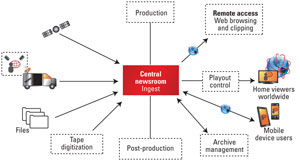Today's digital newsroom
The advent of the 24-hour news cycle and the tremendous number of broadcast outlets covering local, regional and global news are driving a technology revolution in today’s newsrooms. Being relevant and gaining and keeping viewers depends on speed and agility. In the newsroom, time is money.
Quickly and reliably executing the entire production workflow is critical to news organizations. End-to-end live broadcast technology enables stations to gather, prepare and broadcast news as it breaks. Within this workflow, integrated editing, storage, and archiving tools and software are delivering new speed, reliability and capabilities. Nonlinear editing tools provide timeline editing with no rendering required for fast-turnaround news production and to improve rough-cut edits by adding text, graphics and voice-over recordings.
Highly flexible storage solutions, based on scalable and modular architecture and including metadata, enable operators and journalists to browse and search by keywords, and to edit content. Content can also be instantly accessed throughout the entire network for production, editing or playout. Today’s editing, storage and archiving tools are more nimble and robust than ever before, bringing new levels of speed, productivity and reliability to newsrooms and to our daily news.
Creating the workflow
Moving the production workflow from tape-based to digital was the first step of innovation and ushered in a tremendous change to the industry and to those who work in television news. But the innovation hasn’t stopped there. Advances across the workflow — greater integration, more speed and new agility — are making newsrooms themselves more scalable, flexible and streamlined, and thereby more cost efficient. Modular and open systems are delivering outstanding returns on investment. Let’s take a look inside the digital newsroom, an example of which is shown in Figure 1, and see how it all happens.

Figure 1. The new digital newsroom is fast, integrated and tapeless — and capable of making news available to consumers on a range of devices.
Ingest. Ingesting live video feeds is where the production process begins. In the most productive newsrooms, any SD or HD feed can be ingested, most often through an encoder platform or server-based technology. Best-of-breed encoders support all codecs and formats, and can be configured either as an encoder or playout channel for maximum infrastructure flexibility. Intelligent server technology handles all ingest functions, recording multiple video feeds and making this media available throughout the production workflow for simultaneous preview, rough editing, archiving, playback or post-production. A process of loop recording can ensure that no incoming feeds are missed during recording, even when they’re not scheduled or managed. The feeds are then available throughout the production network.
Regardless of ingest method, the ingest process must be managed. In today’s workflows, this is most often achieved through integrated production management applications that give the user complete control of production workflow, from ingest control and metadata management to on-the-fly editing and playout scheduling, often from a single intuitive interface.
Ease of use is key, with the goal of enabling every member of a production team to use the system without extensive training. Talent should be focused on operating and editing tasks, not on figuring out how to use complex systems. These systems must also integrate with third-party resources. System and components accessibility is critical, as it helps streamline all aspects of the workflow and save resources.
A discussion of media ingest is not complete without addressing storage. The ability to easily access and browse stored media is a critical aspect of the entire workflow and can be a significant stumbling block if not handled correctly. Footage from ENG crews can be imported directly — in the right format and codec — with simple tools that enable editing, browsing, transfer and transcoding of all clips to central storage. These management tools send all media to central storage, often removable storage platforms well suited to live broadcast operations. Regardless of media origination, these systems offer short- and long-term archiving of clips, audio/video feeds and highlights with all associated metadata, where editors can easily browse and search content by keyword or edit media content. Media can also be accessed throughout the entire network for production, editing or playout.

Sky News Arabia uses EVS XS servers, IPDirector video production management suite, Xedio CleanEdit editing applications and XStore SAN storage in its digital newsroom.
Content management and timeline news editing. Once content is quickly and efficiently ingested and stored, it needs to be ready for immediate editing and preparation for air. Workstations are equipped to allow users to browse incoming feeds and prepare rough-cut edits by creating simple playlists. Playlists can then be pushed to nonlinear editing systems, allowing access to any frame in a clip for additional editing, or directly to playout if required.
This allows editors to use the wide range of nonlinear editing and news cutting tools available in the marketplace today, and greatly improves the speed and quality of their media editing. For instance, timeline editing with no required rendering is used to improve rough-cut edits by adding text and graphics, to prepare news reports, and to enable voice-over recordings. Support for multiple formats and resolutions on the same timeline and robust metadata management features are other examples of tools that can increase editing speed and quality.
Post-production integration. Digital workflows should fully integrate craft editors with ingest and production processes and online storage, facilitating rapid file exchange with external post-production applications. Editing suites often use plug-ins to enable rapid post-production file rendering so playout begins as soon as editing is completed. Production systems should seamlessly integrate with all major editing software from Avid, Apple and Adobe.
Playout. Like other parts of the digital production workflow, there is more than one option for playout. Server technology, encoder/playout systems or even off-the-shelf newsroom control systems (NRCS) such as ENPS can accommodate playout. The key is interoperability. Playout technology — either via a server or encoder — and software-based management technology must interoperate to achieve successful playout operations, ensuring all clips and associated metadata can be accessed, complete playlist functions are facilitated, and news stories are managed across the news workflow. Additional tools and software enable capabilities such as live slow motion and timeslip operations for fast review of events, or delay of events so that nothing is missed.
Web service integration. As media organizations move to push their news over multiple platforms, Web service integration is an increasingly important part of the process. Metadata is added to the workflow system, indicating which platform should receive media files and the type of content contained within the file.
One size does not fit all
There are many options, both in terms of system architecture and software and hardware, to achieve highly reliable and digital workflows. There are now turnkey, yet feature-rich, systems designed for small and regional newsrooms. There is no right answer, only the best fit for an individual news organization. How many feeds must be handled? Is the newsroom operating globally, regionally or locally, and is this reality likely to change? Parameters such as budgets, future plans and existing infrastructure can all play a part.
Integrated digital systems provide the ability to scale and evolve with a broadcaster’s needs. They need to be nimble to accommodate technology advancements, organizational changes or new workflow approaches. Yet building these types of systems requires long-term commitment and trust between broadcaster and technology provider.
New challenges are sure to emerge. Many news providers are now operating as multiplatform providers, making news available online, on radio, and to a range of connected devices — including mobile phones and laptops — so consumers can access news at all times, wherever they are. This capability is critical to leveraging greater revenue and reaching larger audiences in the future. There’s a new breed of newsroom: It’s tapeless. It’s fast. It’s scalable. And it’s fully interoperable
—Henry Alexander is SVP, entertainment and news, at EVS.
Get the TV Tech Newsletter
The professional video industry's #1 source for news, trends and product and tech information. Sign up below.
